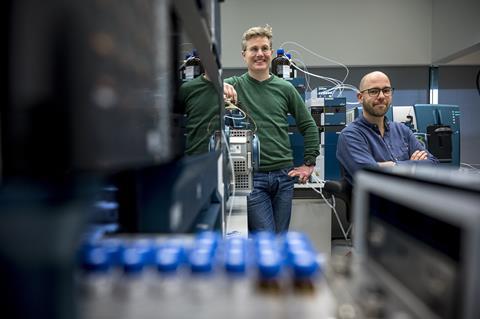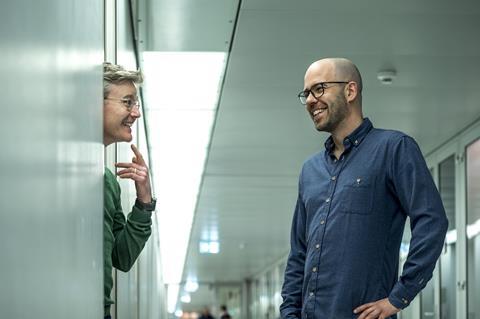Was there a muscle relaxant or GHB administered to a victim? Did someone commit a crime while under the influence of drugs? These are daily questions for Rogier van der Hulst and Dick-Paul Kloos of the Netherlands Forensic Institute. ‘Sometimes, the truth really is stranger than anything I could imagine.’
Forensic toxicology is a combination of biology, chemistry and medicine. ‘The leading question for us is always whether a foreign substance is involved, which could have caused a certain effect,’ explains Rogier van der Hulst, forensic toxicologist at the Netherlands Forensic Institute. ‘This is a medical question that we have to answer with the help of chemistry.’ A common example is to check the blood for alcohol in case of a traffic accident. But Van der Hulst and his colleague, analytical chemist Dick-Paul Kloos, also work on homicide cases. Their Toxicology Department processes 1,500 to 2,000 cases a year.
Van der Hulst determines what needs to be examined and then Kloos devises the necessary analytical methods and, if necessary, develops new ones. Van der Hulst subsequently interprets the results and explains the findings in court. Van der Hulst: ‘We constantly complement each other. Dick-Paul works on the technical aspects needed to measure a substance, and I work out how the compound affects the body. The molecule is our connection.’
Their close collaboration is evident during the interview. Both of them constantly add on to what the other one is saying. Kloos: ‘Sometimes Rogier wants to measure a substance with a very low concentration, which means that I need to come up with additional tricks, but then I may need to use more blood. Rogier can then intervene because he wants to do other types of analysis on the blood as well.’ Van der Hulst: ‘It is also possible that we cannot use the standard method.’
Can you give an example of such a case?
RvdH: ‘Suppose a seriously decomposed body is found and there is no blood anymore. We may want to examine whether GHB is present, and normally we test this in the blood. In this case, however, brain tissue offers the best alternative. Dick-Paul and I then decide if there is enough tissue, what method we should use, how to prepare the sample and which type of analysis is suited best for this purpose.’
‘You have to decide whether you’re going to look for the substance or its metabolites.’
Dick-Paul Kloos
What have been the most important changes in your field over the past 20 years?
DPK: ‘Until twenty years ago, we could only detect a limited number of substances simultaneously. We used to collect samples until the batch was filled up and then measure everything at once. That could take a week. Now, we perform these analyses three times a week, even when batches are not incomplete. Also, we used to perform immunochemical analyses to distinguish, for example, cocaine from amphetamine, but that method did not reveal which amphetamine. That required additional studies. Today, we use high-resolution mass spectrometry. It allows us to measure hundreds of substances simultaneously and pinpoint the exact substance.’
RvdH: ‘Another important aspect concerns the increased sensitivity of the methods, which enables the use of smaller samples. Twenty years ago, for example, we still needed three milliliters of blood for all examinations, now only half a milliliter or less will suffice. That is a huge difference. We don’t always have a lot of material to work with and therefore we sometimes need to make difficult decisions about which analysis to run.’
‘We don’t always have a lot of material to work with’
Rogier van der Hulst

Has the field become more complicated, because more options are available?
RvdH: ‘I think it has become easier, but you have to consider more possibilities and you obtain more results. You can even detect substances you do not really want to know about.’
Such as?
RvdH: ‘If you can measure very low concentrations, you can also encounter, for example, all kinds of nutrients or substances that we are all exposed to just by walking down the street.’
DPK: ‘Take GHB, for example. We all have tiny amounts of GHB in our bodies. However, only in high concentrations does it cause intoxication.’
What technical problems do you still encounter?
RvdH: ‘There is always room for improvement. We would like to do more research in a more discovery driven, undirected manner. Right now, you often compare substances to a library. It would be nice to be able to identify any substance without having to decide beforehand what it might be.’
DPK: ‘Looking at the analytics, I also see data challenges. The more you measure, the more data you generate. We need good software and more skilled people to properly organize the data.’
RvdH: ‘And more computer power for faster analyses. When working on a homicide, you would rather have the results in a week than in a year.
‘With high resolution MS, we can measure hundreds of substances at once’
Dick-Paul Kloos
A year seems pretty hypothetical, right?
RvdH: ‘Yes, that is true, but still the standard for toxicology research is three months. That is too long, in my opinion.’
Why does it take so long; is that only due to a lack of computer power?
RvdH: ‘No. When investigating a cause of death, you often do not know what you are going to encounter. Sometimes you complete the work within days, but there are also more complicated cases. Then you try out several techniques, one by one. Eventually you may find an increased concentration of a certain substance. But you also need pathology to determine the cause of death. We need to know whether a victim has suffered an injury, if there has been a brain hemorrhage or if someone can tolerate high concentrations. The combination of toxicology, pathology and histology can take a long time.’
DPK: ‘Sometimes, it is also due to silly practicalities. If you need a reference substance that is only available in Canada, it may take two months to get an import license.’
Recently, the NFI announced a new research project in collaboration with the University of Groningen (RUG), Amsterdam UMC and VU Amsterdam, which allows simultaneous examinations of, for example, a single tooth or a single nail. When would this be relevant?
RvdH: ‘For example, when a body is discovered and skeletal remains are all you have. Or in cases where criminal involvement comes to light at a very late stage, meaning that the body needs to be exhumed. Or when body parts wash ashore. In toxicology, we do not often work with teeth and nails, but you can retrieve a lot of information from them.
What information, for example?
RvdH: ‘We came across traces of hospital medication, for example. But you can also detect signs of drug use, in the weeks prior to death, in a tooth. With the help of isotope research at VU, we can determine someone’s geographical origin, based on certain foods that are characteristic of the area. And with carbon dating at RUG, we can determine a person’s birth date from the root of a tooth, and the year of death from the nails. We can also extract DNA to determine a person’s sex. By properly dividing and processing the teeth and nails, we can perform all examinations without getting in each other’s way.
The two ended up at the NFI fairly quickly after completing their studies. Kloos: ‘I wanted to do an internship at NFI during my master’s, but on the recommendation of my supervisor, I first went to the Leiden University Medical Centre for my PhD research. There, I learnt a lot about chromatographic techniques, spectrometry and biological sample determinations.’ After completing his PhD, he spotted a vacancy at the NFI and seized the opportunity. ‘Forensic toxicology turned out to be right up my alley. ‘That CSI feel of the work I do is fantastic; I can encounter a case in the media and think “this is on my desk”, I can help solve this.’
Van der Hulst: ‘After five years as a hospital pharmacist, I knew that I wasn’t going to do that until my retirement. What affects me most is injustice, so I thought about the police or the judiciary. Then I saw a vacancy at the NFI and there, I felt completely at home.’

Do you have a case that has stuck with you?
DPK: ‘The poison murders in Amsterdam [in 2013, ed]. Young, healthy Dominican men were killed using the muscle relaxant succinylcholine, in order to collect insurance money.’
RvdH: ‘This substance is only effective for a few minutes. In the hospital, it is used to intubate a patient. But if you do not intubate someone after injection, they will suffocate while being fully conscious. A horrendous death.’
It was a smoking gun, as I think I will never encounter again.
Rogier van der Hulst
DPK: ‘Analytically, this was very challenging because the substance quickly disappears and is thus incredibly difficult to detect in the body. Therefore, you have to stabilize the blood as soon as you can. And you have to think about whether you are going to search for the substance itself or its metabolites.’
RvdH: ‘Moreover, it is a substance that sticks to glass, so we had to convert the method and work with plastic.’
How did you know you had to look for succinylcholine?
RvdH: ‘We immediately had the feeling that something was off, so we asked the police to search for drugs. They found ampoules of succinylcholine as well as syringes at the suspect. It was a smoking gun, as I think I will never encounter again. We had proved that the two victims had succinylcholine in their blood, the syringes found contained the substance, the pressure side of the syringe contained the suspect’s DNA, and the needle side contained the victim’s DNA.’ [In 2016, the perpetrator was sentenced to life in prison, ed.]
Rogier; in the hospital you thought ‘I do not want to do this until retirement’. But with this job you do?
RvdH: ‘Yes definitely, forever.’
DPK: ‘That applies to me, too.’
RvdH: ‘I can reveal what happened to people who can no longer tell their story themselves. That is what makes this work so worthwhile and exciting. Sometimes, the truth really is stranger than anything I could imagine.’













Nog geen opmerkingen